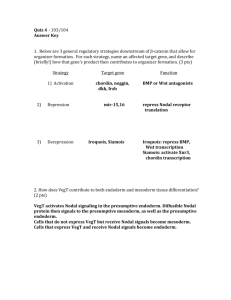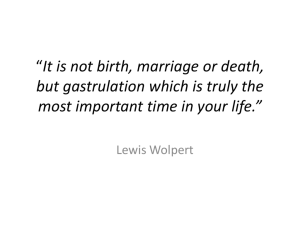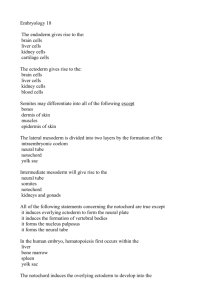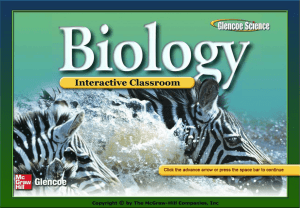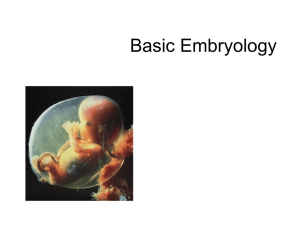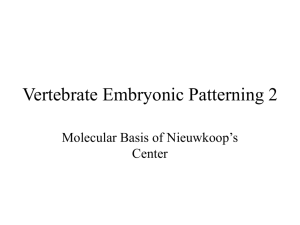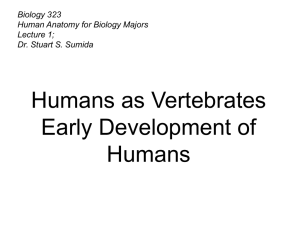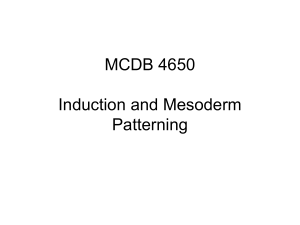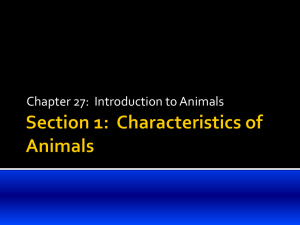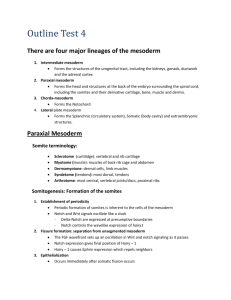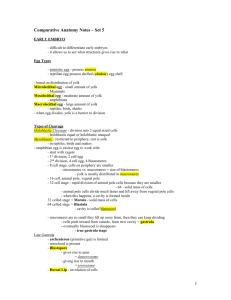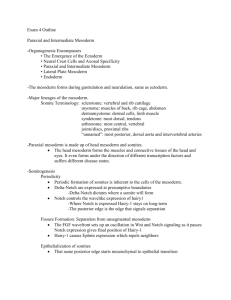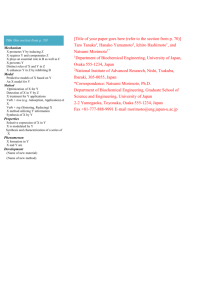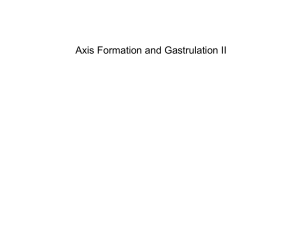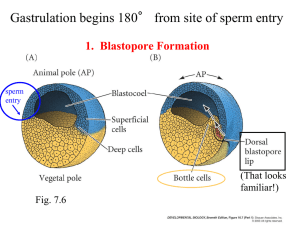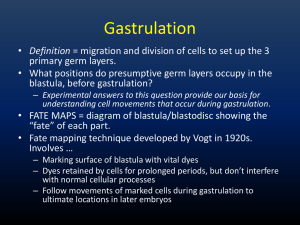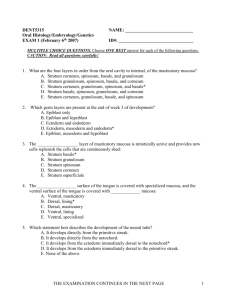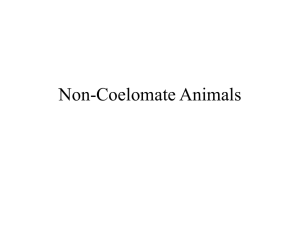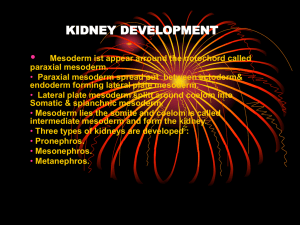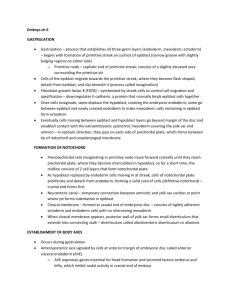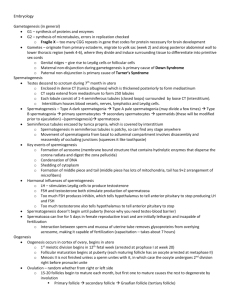Germ Layer Formation/Fate Mapping (Slagle)
advertisement
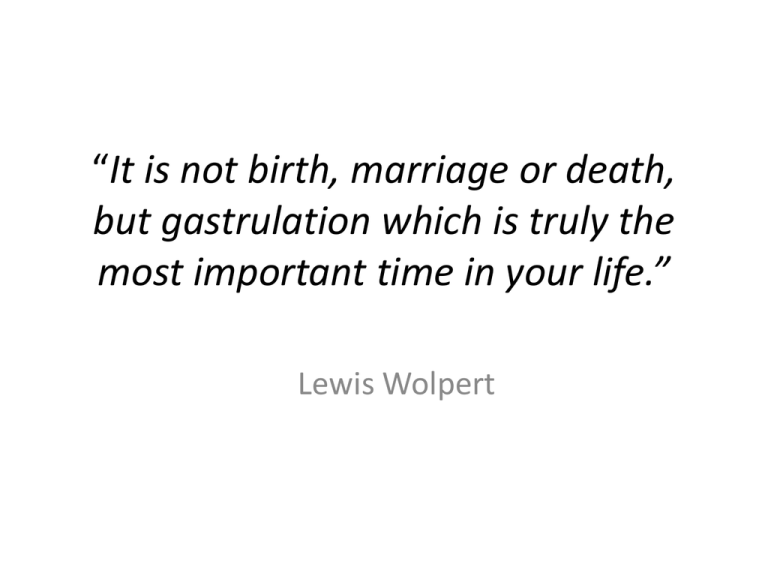
“It is not birth, marriage or death, but gastrulation which is truly the most important time in your life.” Lewis Wolpert Germ layer formation: from blastula to animal onset of zygotic transcription Germ layer formation: from blastula to animal Fate-mapping the early Xenopus embryo animal vegetal blastula Fate-mapping the early Xenopus embryo animal ectoderm (epidermis, nervous system) mesoderm (blood, muscle, kidneys, bones) endoderm (digestive, respiratory systems) vegetal blastula Origin of mesoderm: Nieuwkoop experiments ectoderm ectoderm What happened to mesoderm? endoderm How is endoderm formed? Origin of endoderm: maternal factors • maternally supplied transcript animal •T-box transcription factor • activates endoderm cascade cell-autonomously maternal vegT vegetal • inhibition blocks endoderm (and mesoderm) formation Cell autonomous and non-autonomous effects Cell autonomy: genetically mutant cell/tissue exhibits phenotype associated with loss of gene product (gene product required by cell producing it) Cell non-autonomy: genetically mutant cell/tissue causes phenotypes in other (genetically wild-type) cells (gene product required by cells other than those producing it) X X A X X B Origin of mesoderm: Nieuwkoop experiments • mesoderm induced from ectoderm when apposed to endoderm • effect has limited range (4-5 cell diameters) • origin of “animal cap” assay Origin of mesoderm: Nieuwkoop experiments • induction event tolerant of small physical separation (filter or spacing between tissues): secreted molecule(s) responsible Origin of mesoderm: Nieuwkoop experiments • type of mesoderm induced depends on duration of contact with endoderm/signal Origin of mesoderm: Nieuwkoop experiments “young” • “heterochronic” transplants: competence of ectoderm to form mesoderm restricted to gastrula stages “old” What is the mesoderm-inducing signal? • secreted factor • act at a distance • expressed by endoderm at right time (late blastula/gastrula stages) • ectoderm competent to respond Finding the signal: • “cut and dump” cap assay: expose caps to candidate secreted factors, assay for response • functional cap screen: inject eggs with candidate genes, cut young caps, assay for response • expression screen: determine endoderm-specific transcripts • 30+ years of screening: TGFβ and FGF signaling What is the mesoderm-inducing signal? What is the mesoderm-inducing signal? FGF signaling pathway What is the mesoderm-inducing signal? • brachyury: founding member of T-box transcription factor family • expressed throughout mesoderm • crucial for posterior mesoderm development (similar to FGFs) Additional findings • Brachyury activates Fgf expression, leading to positive feedback loop • FGFs do not induce the entire mesoderm spectrum, only posterior fates • FGFs do not have unique targets involved in mesoderm induction Additional findings • VegT directly activates expression of Nodal • Nodals induce expression of their antagonist, Lefty (mechanism for restricting inductive properties) Making matters more complex… animal Spemann’s organizer (dorsal blastopore lip) vegetal ventral β-catenin dorsal • vegetal β-catenin moves dorsally after fertilization • induces high levels of Nodal expression • Nodal induces expression of “dorsal determinants” Discovery of the dorsal organizer Spemann-Mangold experiment *Donor organizer will induce/respecify host tissue to more dorsal fates!* Spemann’s organizer: patterning the DV axis animal vegetal ventral high Nodal dorsal ventral dorsal Spemann’s organizer: patterning the DV axis Bra Gsc Nodal ventral dorsal Spemann’s organizer: patterning the DV axis Evolutionary conservation of mesoderm induction yolk Main differences • holoblastic vs. meroblastic cleavage • endoderm formation is cell non-autonomous • no maternal VegT homologue (zygotic homologue does not activate Nodal expression) Evolutionary conservation of mesoderm induction ectoderm neuroectoderm mesoderm ventral lateral dorsal endoderm (gut) organizer yolk ectoderm tail somites and neuroectoderm yolk “no Nodal” Conserved mechanisms • Nodal signaling is required • β-catenin induces high levels of dorsal nodal • dorsal organizer (shield) inhibits ventral signaling for DV patterning • brachyury expressed throughout mesoderm • Wnt, FGF, BMP signaling maintain and pattern mesoderm fates Recap: vertebrate germ layer formation • Endoderm origin varies between species – Cell autonomous in Xenopus: maternal VegT – Cell non-autonomous in zebrafish: maternal YSL signals • Mesoderm is induced by signals (e.g. Nodal) from endoderm and maintained by feedback loops (FGF-Wnt-Brachyury) • Concurrent with dorsal-ventral patterning – Non-dorsal mesoderm produces FGFs, Wnts, BMPs – Dorsal organizer inhibits ventral signals to form signaling gradients and pattern mesoderm Applying knowledge of embryonic tissue induction Applying knowledge of embryonic tissue induction mouse embryonic stem cells induced to cardiac muscle using FGF, BMP, and low activin; day 7 of induction protocol
